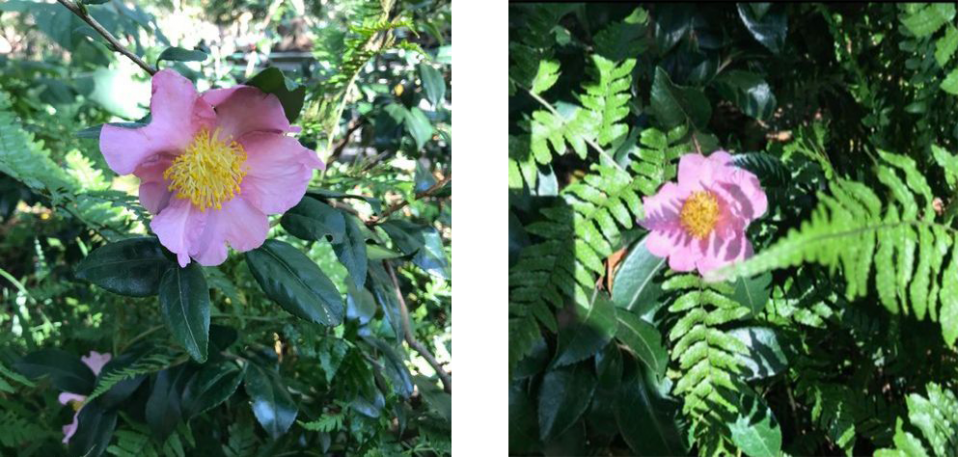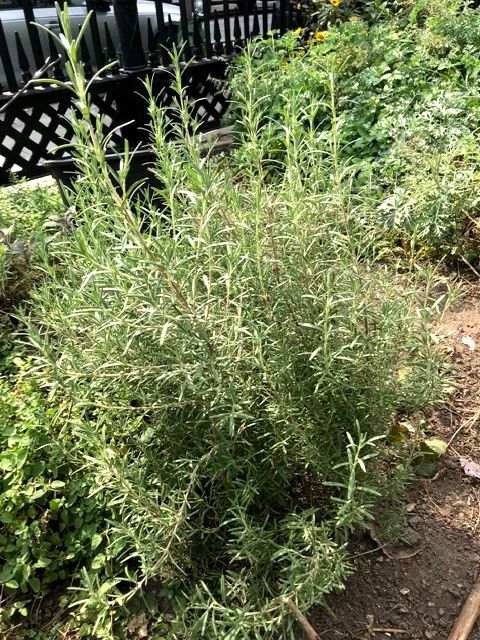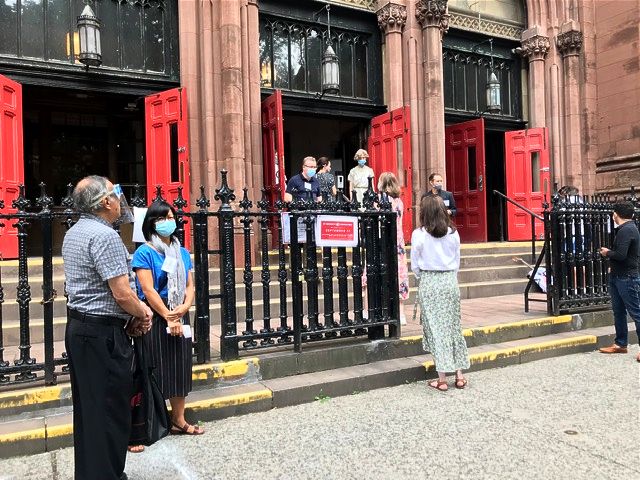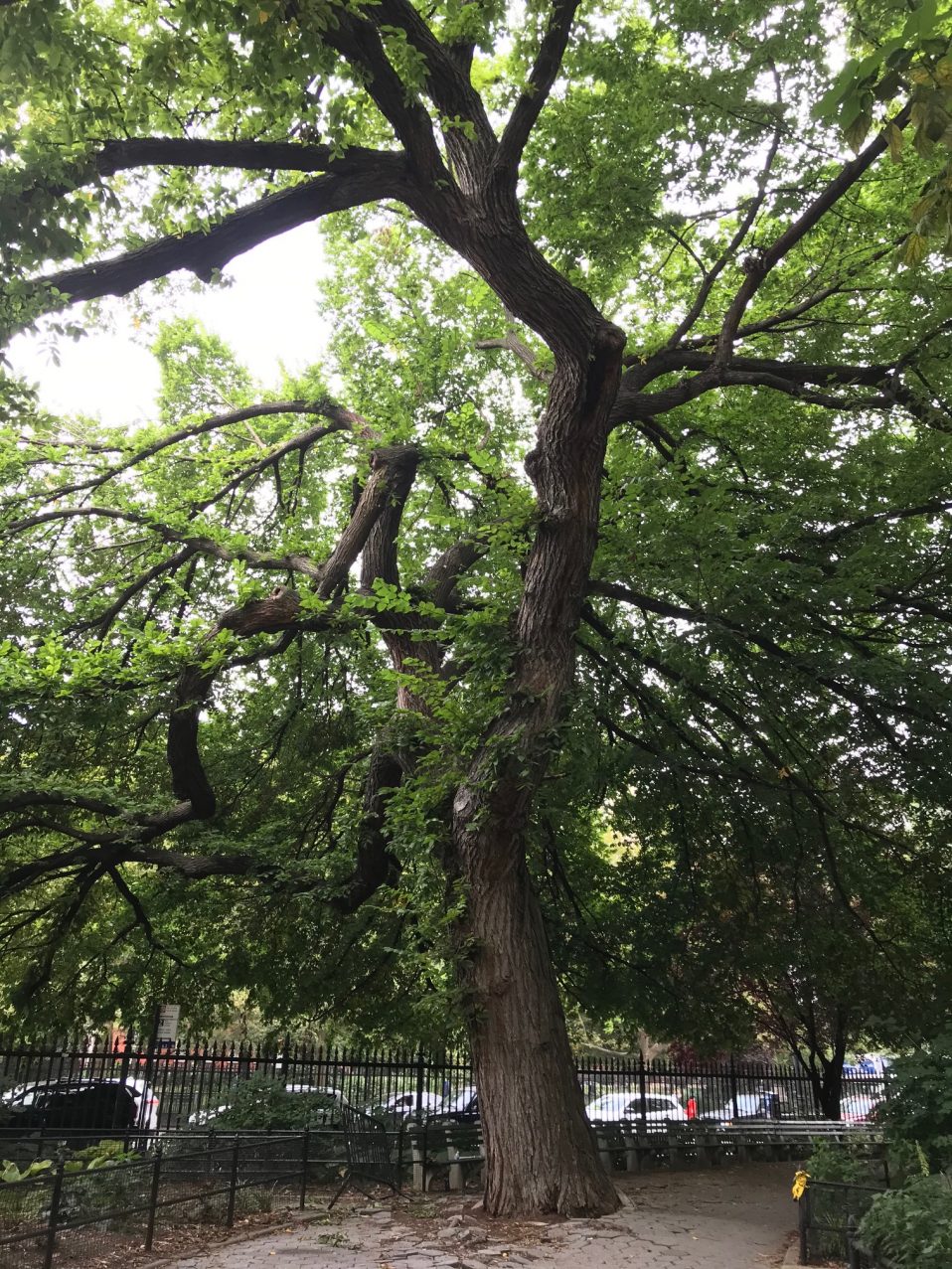On November 11th SPNA hosted our very! The talented Alex Nguyen and band with Vanisha Gould on vocals preformed a wonderful evening of jazz classics for our commuity and friends. We had 200 registered viewers and some were watching from as far away as Australia! The event raised over $1400 toward the Save Our Elm Trees campaign and eveyone had a great time! Thanks to all that attended.
Camellia: The “Winter’s Rose”
Camellias are a genus of flowering plants in the family Theaceae, also known as the “tea family.” The evergreen shrubs or large trees can grow up to 66 feet tall. Their flowers range in size, shape, and color, coming in whites, pinks, and reds with single or double rows of petals. Depending on the variety, camellias grow during the fall, winter, and/or spring. They flourish in colder temperatures in the shade and can withstand large volumes of water. The camellias in our park (pictured above) are called “Winter’s Rose.” They are a smaller, very hardy variety, and they bloom for four to six weeks in the fall.
The composition of camellias and their color are all thought to represent different aspects of love. The petals of the flower symbolize a person, while the calyx (green part that holds everything together) is thought to represent their partner. Unlike other flowers, the calyx of the camellia falls with the petals, symbolizing unity and undying love between lovers. Red camellias are associated with passion and desire, while white camellias are generally associated with innocent love. Pink camellias are associated with the desire to be with a loved one, and relate to long distance relationships and love that is just out of reach.

Sparrow and Snow-covered Camellia, ca. 1845, Japan The Met JP2535
Camellias and their meanings originate in East and South Asia. The first fossils of camellias were found in Japan and date to the Eocene Epoch, which occurred roughly 56 to 33 million years ago. They are called tsubaki in Japanese, cháhuā (tea flower) in Chinese, and dongbaek-kkot in Korean. Camellias appear as motifs throughout the regions’ histories, in paintings, on ceramics, textiles, and other objects (see at right and below). They are still traditionally used in celebrations of Chinese New Year and Korean wedding ceremonies because of their associations with love and good fortune. The plant can be processed into oil used for cooking and cosmetics, and is used in traditional Chinese medicine to treat various diseases, such as asthma and bacterial infections. Most popularly, the leaves of a particular species of white camellia are used to make tea, which spurred its popularity outside of Asia.
Before 1739, when the first live camellia arrived in Europe, people outside of Asia only knew of camellias through artistic depictions and verbal descriptions. For example, the English name camellia is derived from Jesuit botanist and missionary Georg Joseph Kamel, who worked in the Philippines and described a species of camellia. With the expansion of the tea trade in the 18th century, more varieties of camellias were increasingly imported by the British East India Company and began appearing in greenhouses and in beverages on the kitchen table.
As trade in camellias increased, the flower eventually reached the United States in 1797, when industrial pioneer Colonel John Stevens brought the flower as part of an effort to grow attractions within Elysian Fields in Hoboken, New Jersey. By 1807, the plant was widely found in greenhouses, and then was taken outdoors and planted in the American South. By 1959, it was named the state flower of Alabama, and it can still be found across the States. In fact, Alabama, California, Florida, Louisiana, Mississippi, Oregon, and Georgia each have a “Camellia City,” because of the wide presence of the plant.
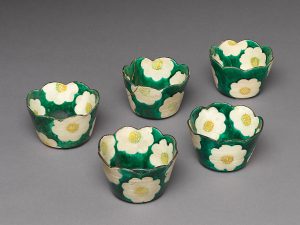
Set of Five Camellia-Shaped Side Dishes with Camellia Patterns, 18th century, Japan The Met 2019.193.56a–e
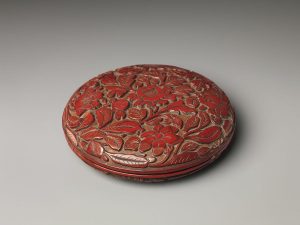
Box with Camellias, 13th century, China The Met 2005.140a, b
The spread of camellias has caused them to hold significant cultural significance outside of Asia. White camellias became a symbol of the women’s suffrage movement in New Zealand and appear on the country’s ten-dollar note. Camellias represent a courtesan’s sexual availability in Alexandre Dumas’s The Lady of the Camellias, the protagonist of which inspired Coco Chanel to use a white camellia as the symbol of Chanel haute couture. The Knights of the White Camellia was an American terrorist organization with ties to the Ku Klux Klan that supported white supremacy and slavery in the 19th century. In contrast, the camellia was also a symbol of Brazil’s abolitionist movement, and it was common practice for abolitionists to plant camellias in a show of solidarity.
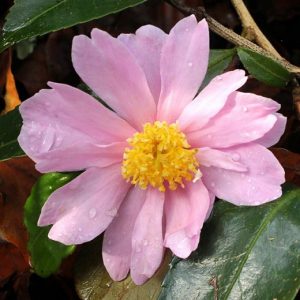 Because of their association with longing, the pink “Winter’s Rose” camellias in our park (at right) can be thought to poetically symbolize the distances we have created while in quarantine. We may long for our friends, family, and the nostalgia of pre-pandemic times. Yet, there is also a delicate beauty in our longing that will make the experience of finally being reunited so much sweeter.
Because of their association with longing, the pink “Winter’s Rose” camellias in our park (at right) can be thought to poetically symbolize the distances we have created while in quarantine. We may long for our friends, family, and the nostalgia of pre-pandemic times. Yet, there is also a delicate beauty in our longing that will make the experience of finally being reunited so much sweeter.
Rosemary: Memorable and Delectable
Rosemary is an herb with fragrant, evergreen needle-like leaves native to the Mediterranean. White, purple, blue, or pink flowers bloom on the plant in temperate climates, but it can sometimes also bloom unexpectedly in the dead of winter. Its name is derived from the Latin ros marinus, or “rose of the sea,” because it thrives at low altitudes, which are associated with the seaside. The plant is hardy; it can survive extended droughts and cold temperatures, and can live for about 30 years.
The first mention of rosemary was found on cuneiform tablets from the Ancient Near East in 5000 BCE. It was considered sacred by the ancient Egyptians, Greeks, and Romans and was extensively written about in ancient texts. The plant made its way to China in the third century, then Europe around the eighth century, and was eventually brought to the Americas by settlers and traders in the seventeenth century.
Throughout its history, rosemary was heavily associated with promoting memory and mental clarity. Ancient Egyptians placed rosemary in tombs and used them in bouquets of funeral flowers and embalming practices in order to remember the dead. Students in ancient Greece wore garlands of rosemary around their necks, or braided it into their hair to improve their memory during exams. Others would place it in their pillow the night before to enhance memory during sleep. Rosemary was also heavily used in weddings to help memorialize the occasion. It was incorporated in a bride’s adornments and added to the couple’s wine to help them remember their vows to each other. Quite famously, in William Shakespeare’s Hamlet, Ophelia says, “There’s rosemary, that’s for remembrance. Pray you, love, remember.” Today, rosemary is still used to promote mental health and memory, in addition to other medicinal uses, such as hair growth, muscle relief, and skin hydration. However, the scientific weight of these claims are still being analyzed.
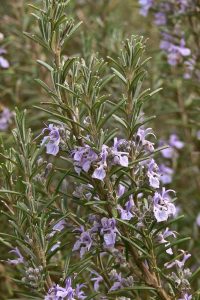 Rosemary continues to have a plethora of uses. It is used for decoration because of its hardiness, bright flowers, and ability to be pruned into various shapes. It also repels pests, such as cockroaches, mosquitoes, slugs, and snails. But it is perhaps most widely used for consumption as a seasoning for meat, vegetables, fish, soup, salads and more. It has a slightly minty, sage-like, peppery taste with a bitter, woody aftertaste and adds character to meals.
Rosemary continues to have a plethora of uses. It is used for decoration because of its hardiness, bright flowers, and ability to be pruned into various shapes. It also repels pests, such as cockroaches, mosquitoes, slugs, and snails. But it is perhaps most widely used for consumption as a seasoning for meat, vegetables, fish, soup, salads and more. It has a slightly minty, sage-like, peppery taste with a bitter, woody aftertaste and adds character to meals.
Nestled in one corner of our park is an herb garden with rosemary, mint, thyme, and other plants. Although the section is small and to the side, it still remains “memorable.”
St. George’s Reopens
 St. George’s Episcopal Church resumed in-person services on Sunday mornings, beginning last month. Pictured at right is Reverend Jacob Smith, ready to welcome parisioners.
St. George’s Episcopal Church resumed in-person services on Sunday mornings, beginning last month. Pictured at right is Reverend Jacob Smith, ready to welcome parisioners.
Per city guidelines, the church is functioning at 25% capacity. Those wishing to attend services must reserve their spot in advance by clicking here. The link will be refreshed and opened every Monday at 9am.
Save our English Elms
Last month, we shared how the statues in our park are meticulously cared for by the city’s conservation technicians. They are some of the oldest residents in our park, but our English elms are even older and they need your help.
Stuyvesant Square Park is fortunate to have two heritage English elms that are well over 100 years old. Heritage trees are unique and have irreplaceable ecological, aesthetic, and historical value. The elms in our park are in need of critical professional help. They require extensive pruning, cabling to protect and strengthen them from storms, and other support to ensure they remain healthy for all to enjoy.
Although we’ve raised about $2,200 toward safeguarding these trees, we’re still very short of the $7,000 needed. That’s where we need your help. Donate here on our crowdfunding site. Partnership for Parks will match your generous donation, meaning your efforts will go twice as far!
SPNA relies on your generous donations to keep our park and neighborhood clean, safe, and beautiful. Help us by coming together to protect our park’s unique heritage so that future generations can enjoy its benefits and connect themselves to our shared past.



